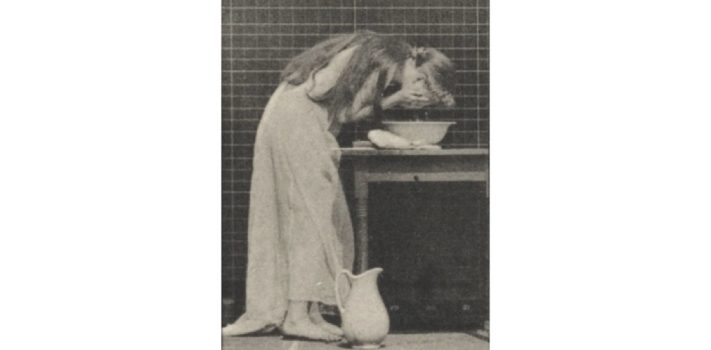Have you ever wondered how people cleaned themselves for centuries without access to a thousand different commercial soaps, shampoos, and lotions? Several answers lie in the treatments below, which largely utilize kitchen staples, and, in many cases, only one or two ingredients.
Ancient Romans, for example, slathered olive oil on their skin and then scraped it off with a dull blade (called a strigil), removing dead skin cells and moisturizing the skin at the same time. Contemporary friends in India swear to the efficacy of coconut oil for their luxuriant hair and lovely skin. A clay tablet, from about 2200 BCE, describes medical treatments involving washing, then making a plaster of mud, and then bandaging. So it is not a surprise that many ancient people, including the Romans, Greeks, and Britons, organized public baths in locations of salubrious mud that they found healing and comforting. Evidence of soap made from animal fat and ashes date to 2600 BC.
For Christmas, I asked my husband to give me a day of spa treatments that he could make from kitchen staples. To my delight, he enthusiastically looked up recipes online and in my herbal books and gave me the best Christmas present ever, including some likely used for centuries by people in their homes.
Give some of these a try, maybe with a friend or two, and save hundreds of dollars on prepared hygiene products.
Hair and face: Mix equal portions of plain yogurt and honey. (For short hair: one tablespoon of each). Rub into the hair, scalp, and face. Leave it on until it feels dry. Rinse it off. The lactic acid in the yogurt gently exfoliates the skin, reducing any itchiness, and the honey is a humectant, that moisturizes the skin and hair. Extra: you can add pureed fruit. Strawberries or raspberries add seeds for a bit of a scrub. Peaches smell divine.
Face mask for oily skin: Mix a paste of turmeric and water. (About 1 tablespoon of each). Paint on the face or just around oily areas, like the nose. Leave it on until it dries and tightens. Note: turmeric will stain the bowl in which you mix this and any cloth you use to remove it. So if you like this treatment, you might decide to dedicate one cloth and one plastic or glass container to this treatment.
Face mask for any skin: Mix a paste of bentonite clay with water or vinegar. The clay absorbs a LOT of water, so start with 1 tablespoon of the dry clay and ¼ cup of water. Any extra can be stored in a lidded jar for future use. Slather on the face and neck, avoiding the eyes. Let the clay dry for about 10 – 15 minutes and then rub/scrub off with a washcloth. Apply a lotion (or coconut oil) afterward.
Body exfoliant: Mix sugar (or salt or coffee grounds*) and coconut oil (or an alternative oil) to a desired consistency. Add a few drops of essential oil for scent, if desired. If you do not have essential oils at home, you can add, for scent, a few drops of vanilla, almond, peppermint or other extracts from your baking supplies. Rub as gently or vigorously as you wish. Then rinse. Your feet may be slippery afterward, so wear slippers or socks. The coconut oil will be absorbed by the skin as a lotion.
* Salt can sting if you have any open cuts or sores. The coffee scent is pretty strong if used on the face. Therefore, sugar is my “go-to” ingredient for exfoliation.
A physical exfoliant is a loofah sponge. This is made from a non-edible squash. Every day above -20 F degrees, I climb into our outdoor, wood-fired, soaking tub with a loofah and scrub away. I especially like this in the winter, when my skin gets dry and itchy.
Lip, hand, and foot lotion: Melt coconut oil. Rub a little into the skin, let it absorb, rub in some more.
Shampoo and soap: I have been nervous about making soap with lye, so I don’t. I buy Castile soap in a gallon container and mix a few tablespoons with water, vinegar, and various essential oils for their scents and properties to use for shampoo and soap. A gallon lasts more than a year for two people.
Dental hygiene
Coconut oil: I use this to brush my dog’s gums and teeth (he likes it) and I also practice oil pulling myself with a teaspoon of coconut oil. The lauric acid in the oil adjusts the pH in the mouth, and seems to deter plaque build up.
Oil pulling is an ancient dental hygiene practice. Let some coconut oil melt in your mouth and swish it back and forth through the teeth and around the tongue for several minutes. Then spit the oil out (not into your sink! It will clog!), rinse and spit with water, and then drink a cup of water. I have asked two dentists about this and neither endorses it but both say it will not hurt.
Baking soda: One of my dental hygienists was a big advocate of brushing one’s teeth with baking soda, which changes the pH of the mouth, inhibiting some bacteria for a short period. It also buffs off some teeth stains.
Hydrogen Peroxide: I make our mouthwash with ½ water and ½ 3% hydrogen peroxide, with several drops of peppermint essential oil for scent/flavor. This is supposed to gently whiten teeth, too.
If your bathroom cabinets are clogged with plastic bottles of soaps, shampoos, moisturizers, exfoliators, etc, have fun making a few with kitchen staples. In the future… you may need to.
Mrs. Alaska’s blog about living off-grid in remote Alaska is www.alaskauu1.blogspot.com










